|
RICHARD DUNKLEY AND HIS BUILDING PROJECTS Originally
penned by G. Freeston: This
piece could not have been written without the active help of Ron Greenall. My
thanks also go to Jon Bunker who recently drove me over to visit Richard
Dunkley's grave at Alby, Norfolk.
In the early and mid-nineteenth century there were several branches of the family in Blisworth, from which one individual emerged who was able to seize the exceptional opportunities offered by the times to build up a business on a scale that went far beyond that possible for any of his forebears. This was Richard Dunkley, who died in the rectory at Alby, Norfolk, in 1886, aged 79. There is the likelihood that Richard Dunkley was mentored by his senior, George Wills, at a time (1930s) when both were associated with Blisworth and engaged in building the Stoneworks house and office for the Duke of Grafton. The most obvious sign of his early success in life is The Loundes, a splendid six-bedroom cottage in the early Victorian Gothic manner, with steeply pitched roofs and very ornate barge-boarding, set in a one and a half acre garden, which he built for himself and his family in 1846. An early picture of the house, which was then probably called The Lowndes is shown here. Dunkley lived at the Loundes for most of his career, undoubtedly commuting by train to his various projects. George Freeston wrote: "Another Blisworth landmark of his, which no one who passes through the
village can miss, is the fine stone railway arch under
which the old Towcester to Northampton road passes. Tradition has it that the
contractor who first worked on it in the building of the London and Birmingham
Railway in the 1830s failed to do the job properly, and Dunkley took it over. In
consequence he established a link with what became the London & North
Western Railway Company that was to prove very profitable to him." April 1856 "Dunkley had been an unsuccessful tenderer some years before for the construction of the Northampton station on the Northampton & Peterborough line - the Bridge Street station. He had done other work for the Company, and the questional issue here appears merely to be about the scale". The more noteworthy part of Dunkley's career is reviewed below but, evidently, his reputation had become established with the building of the Blisworth to Peterborough line and with the completion of a hotel adjacent to a new station for Blisworth. Blisworth was to become an important local junction in the railway system. Besides the hotel, many acres of pleasure grounds were later laid out, which became a very popular venue on summer evenings, weekends and holidays for much of the rest of the century. In addition to the railway company, involved in these developments were the 4th Duke of Grafton, the landowner, and Thomas Shaw of the Angel Hotel, Northampton. Shaw was the leading stagecoach operator before the coming of the railway, and he became the landlord of the Blisworth Hotel. Pickering Phipps, the Northampton brewer and later a iron-mining businessman, took on the hotel on a 79-year lease. As well as his own business abilities, Richard Dunkley's connection with these men and their interests, also the Stephensons and the Duke of Grafton, were undoubtedly the reasons why Dunkley was able to make the transition from village builder to large scale contractor. Quite how large his enterprise became did not become apparent until I came across his newspaper obituary of 1886 - see the "Building News" obituary below. Dunkley's operations stretched far beyond the Blisworth and Northampton area. Very little is known about Richard Dunkley. For example, no record of his baptism has yet been found. From the details given with his obituary, he was born at sometime between August 15, 1806 and August 13, 1807. He was presumably born in 1807 to parents Meshack and Elizabeth as may be judged by family references. One theory is that the transcripted records contain an error, see ? mark where (B)urial was mistaken for (C)hristening ie. Birth), and so his birth day would have been March 2nd. An examination of the micro-fiched records of the original records shows it is obvious that a Richard Dunckley really was recorded buried on Mar 2, 1807 as burial and baptisms records were kept on separate pages of the ledger. The extended Dunkley family of Blisworth certainly included at least two Richards who could have died at that time. The baptisms records, however, show no entry for a Richard Dunkley within the appropriate period. It is possible that, instead, the Baptist church recorded the name-giving and in those days there was no law that required a record must be made with the Anglican church. That a family might switch to the Baptist church at that time seems reasonable in view of probably chaos generated by the absence of and no doubt the gossip about the Rev. Ambrose in 1807. Chaos could have reigned over the maintenance of records as well and we are left with nothing definite. In 1827 his marriage to Lucy Carter of Blisworth parish is recorded, he signing the register Richard Dunckley. Again, there is neither record of Lucy's age nor the date of her birth in the records. Of their off-spring, the parish registers record the deaths of no less than three infant daughters between 1832 and 1835 and a son aged 9 in 1837, but Frances, Caroline, Elizabeth, Lucy Emily and Richard Henry survived to adulthood. The 1841 census places him at the Stoneworks, Blisworth. This is interesting since it puts him, while already an established builder, in touch with the Grafton stone quarrying enterprise at a time after the involvement of John Roper.
In 1851, a vast amount of ironstone was discovered in Northamptonshire. As a result of this the London & North Western Railway, (L&NWR), decided to capitalize on this
occurrence by proposing a new railway line between Northampton and Market Harborough. This in itself would open up more of the countryside for rail travel by providing a link between the lines from Rugby to Stamford, and Blisworth to Peterborough.
The contract to build the line was eventually awarded to Richard Dunkley of
Blisworth on the 23rd July 1856, five years after the original proposal. The completion date for the line was given as the
1st June 1858. However, due to unforeseen difficulties, one of which was a landslide in March 1858 at the north face of Kelmarsh tunnel, the line was not finally approved for public use until the
15th February 1859, with the first passenger train running the following day. In addition to the buildings in Blisworth already mentioned there are (or were until recently) plenty of examples of his work in the immediate vicinity and an interesting resume of his work in his obituary given below. In the eighteen sixties and early seventies he built new schools at Collingtree, Greens Norton, Sywell, Paulespury, Tiffield and Roade, several with the bell-towers and wrought-iron weather vanes which Dunkley favoured. He built a new rectory at Roade (now demolished), and Collingtree Grange for Pickering Phipps in 1875, to the design of the Northampton architect, E F Law. He executed a major revision to Pottesbury Church in c. 1848. In Northampton itself he carried out many projects in the three decades from 1850. The Corn Exchange in the Market Place was his work, as was the General Post Office, Abington Street (1868), the New Cattle Market and its roads, new breweries for Messrs Phipps & Co, and Messrs Phillips and Manning. He took down the old Town Hall, and was much involved in construction work needed in the expansion of the town, including the Kettering Road Reservoirs, and the roads and culverts on the new Kingsley Park estate. Amongst the new institutions of Victorian Northampton, he was responsible for the additions to St Andrew's Hospital, and the west wing, school and chapel of the Convent of Notre Dame in Abington Street. Not all these have survived recent 'urban renewal', though many will remember them. Nor have Dunkley projects such as the Northampton to Market Harborough line survived modern railway rationalisation. What is revealing from the detail in Richard Dunkley's obituary is the scale and scope of his work further away from the Northampton area. He did a great deal of work for London & Birmingham, and later the London & North Western Railway Company, building most of the railway workshops at Wolverton, and also much workers' housing and the Mechanics' Institute in that town, and he erected seventy-two railway workers' cottages at nearby Stantonbury. The whole of the great junction at Willesden, several of the loop lines and the railway workers' houses there were his work. And, over forty years, he carried out many further alterations and additions rendered necessary by the great increase in railway traffic. He also carried out some 'heavy works' at Chalk Farm Station, and at Euston; and the stations at Roade, Tring and Cheddington were his creations. In Warwickshire he built Warwick Gaol, the gas-works at Leamington, railway viaducts at Coventry, and the engine-sheds at Rugby. He also built the rectory for the Rev Mr Pulteney at Ashley Canwell Hall, near Sutton Coldfield, and in Northamptonshire he built Carlton Hall for Sir Geoffrey Palmer, Bart. Amongst his industrial buildings were the coke ovens at Woodstone Wharf, Peterborough. Another of his houses was one for Mr Newdegate, MP at Uxbridge.
Jon Bunker's notes arising from a visit to
Richard Dunkley's grave at Alby Church in Norfolk. RICHARD DUNKLEY
The date of 1868 was recorded in Crockford's Directory and ties in with fact that according to the inscription on Puckle's gravestone he was rector at Alby for 40 years. There is a list in the vestry at Alby which states that Puckle was rector from 1888 but this must be a mistake. Edwin Puckle married Elizabeth Dunkley (in Blisworth Church) in early 1869, presumably having got engaged whilst still a curate at Blisworth. Is it possible that upon his retirement, Richard Dunkley left Blisworth, with his spinster daughter, Frances, to go and stay with Elizabeth and Edwin, his daughter and son-in-law in Alby Rectory (now the Old Rectory). This must have been after 1881 since the last date we have found for Richard Dunkley in Blisworth is the 1881 census which records that he was living in The Loundes. This then is the background behind Richard Dunkley being buried at Alby, although there is still no answer to the question of why he was not brought back to be buried with his wife in Blisworth. It is possible that the position of the grave could be of some importance. Both the present rector of Alby and the occupants of the Old Rectory remarked on the 'prominent' position of the graves, being in between the Church and the Rectory. One can understand Edwin Puckle being buried there since having been incumbant for forty years, he had trod that ground more than anyone. But of all the graves, Richard Dunkley's holds the most prominence despite having only been resident at Alby for, at the most, six years. I am beginning to wonder whether Dunkley, who, following a productive and succesful career had some wealth behind him, perhaps established some sort of financial connection with Alby Church - see footnote. Jon Bunker, May 1996. Footnote: Diana Atkinson, who is a great great grand daughter of Richard Dunkley loaned the daguerreotype photos for copying and points out that Richard Dunkley paid regular and substantial tithes to the church (Kelly's Directory, 1883) so perhaps the grave location mystery is solved. |
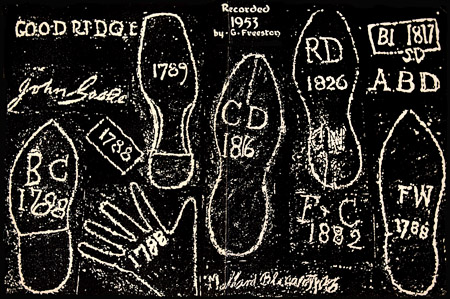 Having spent much of my life recording the
buildings of my native Blisworth, and the lives and times of its inhabitants,
one of the things which stands out is the way trades were passed on from father
to son over many generations. One example is the Dunkleys (or Dunckleys),
carpenters and jobbing builders for three centuries and more in the village, and
neighbouring places such as Gayton, Milton Malsor and Towcester. I came across
them in the parish records and through their initials cut in wood and stone,
often in unlikely places such as the roof of the church, where they left their
hand and foot-prints, often initialled and dated, scored into the leads when they did
repairs. The inset shows Richard Dunkley's mark dated 1826 at the age of
approximately 19 years.
Having spent much of my life recording the
buildings of my native Blisworth, and the lives and times of its inhabitants,
one of the things which stands out is the way trades were passed on from father
to son over many generations. One example is the Dunkleys (or Dunckleys),
carpenters and jobbing builders for three centuries and more in the village, and
neighbouring places such as Gayton, Milton Malsor and Towcester. I came across
them in the parish records and through their initials cut in wood and stone,
often in unlikely places such as the roof of the church, where they left their
hand and foot-prints, often initialled and dated, scored into the leads when they did
repairs. The inset shows Richard Dunkley's mark dated 1826 at the age of
approximately 19 years.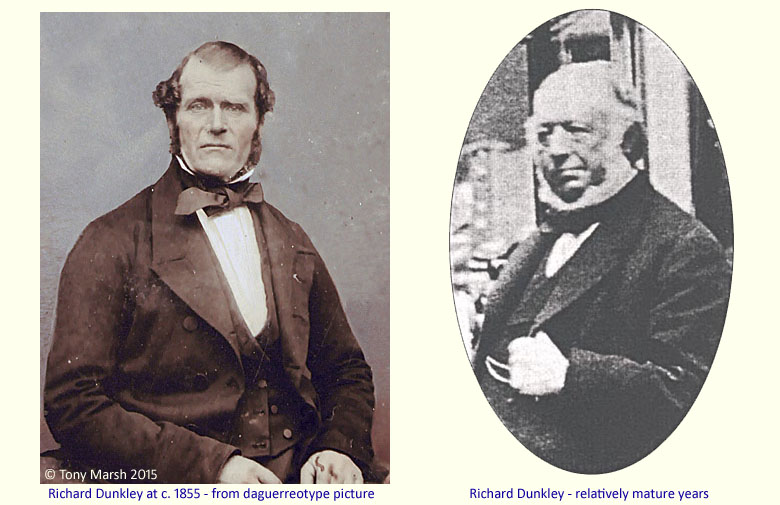
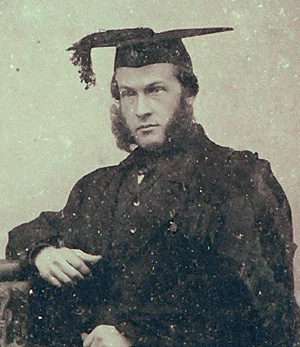 Dunkley was a churchman, and two of his
daughters married clergymen: Lucy the Rev Herbert Price, later rector of
Normanton, Derbyshire, and Elizabeth the
Dunkley was a churchman, and two of his
daughters married clergymen: Lucy the Rev Herbert Price, later rector of
Normanton, Derbyshire, and Elizabeth the 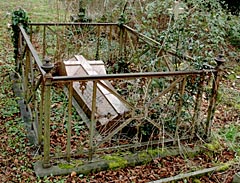 In all this Richard Dunkley the man himself remains elusive and one must assume
he was modest, though we have few other clues
as to his personality. Probate details confirm he left a multi-million pound
estate, when converted to present day valuations. He played little part in village or party politics.
His wife died before him, in 1871 (aged 65), and he was still living
in Blisworth at the time of the 1881 Census. However, he seems to have given up
the Loundes (which passed into the hands of Pickering Phipps, Jnr.) some time
before his death. He died in 1886 in his son-in-law's rectory in Alby, Norfolk,
because he had moved there to be with his daughter, being too old and
infirm to live alone. It is a little surprising that he is buried in Norfolk
rather than alongside his wife who died and is buried in Blisworth, though his death is recorded on her
tombstone which is particularly elaborate, see inset. No doubt there are reasons.
In all this Richard Dunkley the man himself remains elusive and one must assume
he was modest, though we have few other clues
as to his personality. Probate details confirm he left a multi-million pound
estate, when converted to present day valuations. He played little part in village or party politics.
His wife died before him, in 1871 (aged 65), and he was still living
in Blisworth at the time of the 1881 Census. However, he seems to have given up
the Loundes (which passed into the hands of Pickering Phipps, Jnr.) some time
before his death. He died in 1886 in his son-in-law's rectory in Alby, Norfolk,
because he had moved there to be with his daughter, being too old and
infirm to live alone. It is a little surprising that he is buried in Norfolk
rather than alongside his wife who died and is buried in Blisworth, though his death is recorded on her
tombstone which is particularly elaborate, see inset. No doubt there are reasons.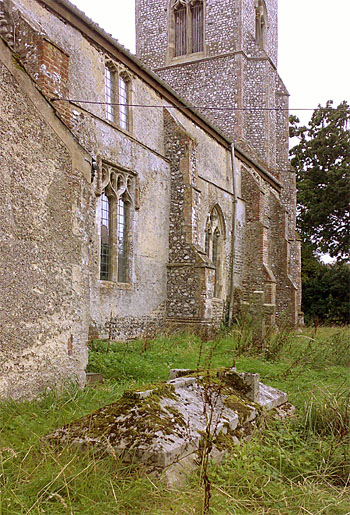 Next to Richard Dunkley's grave, shown here in a photo by Rob Brownlee, there are two
other graves; one is Frances Dunkley, his daughter; the other is Edwin Puckle,
who in addition to marrying another of Dunkley's daughters, Elizabeth, was
rector of Alby church. Further investigation into Edwin Puckle has revealed that
he had been a curate at Blisworth from 1859 to 1868, after which he had become
rector of Alby in 1868 until his death in 1909.
Next to Richard Dunkley's grave, shown here in a photo by Rob Brownlee, there are two
other graves; one is Frances Dunkley, his daughter; the other is Edwin Puckle,
who in addition to marrying another of Dunkley's daughters, Elizabeth, was
rector of Alby church. Further investigation into Edwin Puckle has revealed that
he had been a curate at Blisworth from 1859 to 1868, after which he had become
rector of Alby in 1868 until his death in 1909.